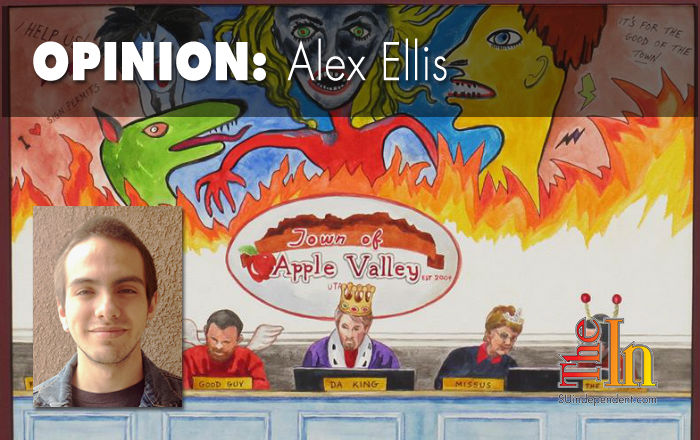
Written by Alex Ellis
Southern Utah is a beautiful place. While it may be more difficult for long time residents to appreciate it compared to the many tourists that come to the area, and while the heat may detract a little from the awe, it is doubtful there are many who would disagree with this statement. In addition to the natural beauty in the area, there is also much artificial beauty to be found in the rising southwestern art community. The local governments have done much to cater to this community by holding art festivals, highlighting local artists, and, in the case of St. George, by spending $4 million in taxpayer money to tear down and renovate the once-popular Electric Theater into an artist co-op. However, in St. George, this apparent support for the arts only goes skin deep.
With the St. George art festival coming up yet again, it may seem to some that the city is a champion of the arts. However, it should be remembered that the art we see is the art they WANT us to see. There are countless paintings and pictures of the same old Zion monuments that get shown off every year; because they are not dangerous to the city. However, art has historically held a political and counterculture nature, and it is this important aspect the city is trying to fight.
Recently an Apple Valley artist named Gloria Charles showed some of her paintings at an exhibit in Springdale. One notable painting was entitled “The King and His Court.” It depicts the Apple Valley city council as a council of royals, with the mayor as the king and the other councilmen his nobles. In front of each member is a name tag with titles such as “Da King, The Weasel, and Rodger That.” While one citizen may have complained about the painting being “too political,” the Springdale town manager upheld the artist’s right to criticize her local government.
It’s likely there are many who appreciate this sort of criticism, and perhaps even more who wish they had the same sort of outspoken criticism of authority in their towns. For St. George, however, this is easier said than done.
For how much the government of St. George likes to go on about how they support the arts, their actions have done little to support their claims.
The city of St. George has a long history of shutting down artistic expression they don’t agree with. Gogo 37, a popular music/art venue with some hints of counterculture, was forced to close down in June of 2012 due to continued harassment from the city which killed business. Less than a year ago, a local dance was shut down preemptively because a teenager made a post on Facebook describing the dance as a “rave.” Even the Electric Theater, despite its long history and popularity, closed its doors for good when the city suddenly purchased it at a price beyond its appraisal.
As one would suspect, these actions have caused some resentment within the local community. Local politician Tara Dunn capitalized on these feelings during the last mayoral election, promising to repeal laws that require a business to have a license granted by the city council to allow patrons to dance. Just last November, around 100 protesters swarmed city hall in defiance of these laws, comparing them to the movie “Footloose” while dancing to the movies title song. Unfortunately, these calls for change fell upon deaf ears.
While artists may depict politicians as kings, St. George city council officials seem to enjoy acting like they are royalty. From the secret meetings leading to the purchase of the Electric Theater, it is clear they do not care for the people’s interest in being involved. From the condescending tone they took towards those who disagree with the dance laws, it is clear they do not respect their constituency’s opinions. And, from their willingness to look the other way as Gil Almquist clearly violated city code, it is clear they do not care for the law.
Given this, it is understandable why some St. George residents may be skeptical about the new art center the city council is currently building. Undoubtedly we’ll have showcase after showcase of the same iconic monuments from Zion National Park, but will we ever see paintings such as “The King and His Court?” Or at least, will we see artistic criticisms without the artist being promptly blacklisted by city officials? In art, expression is everything. Clearly there is a growing crowd in the local community who feel frustrated with their elected representatives, and as we have seen these past few months, they are not afraid to express it. There are few questions that remain: will the city council allow citizens to express their frustration, and even give in to what the people want? Or will they attempt to censor any criticism and pretend that everything is alright?
St. George would do well to keep a close eye on what happens “behind the scenes” in the art community.




